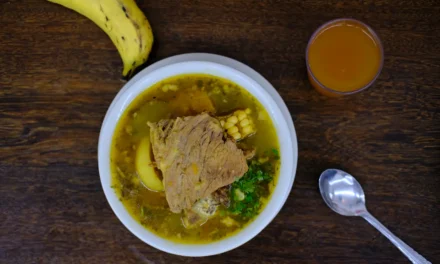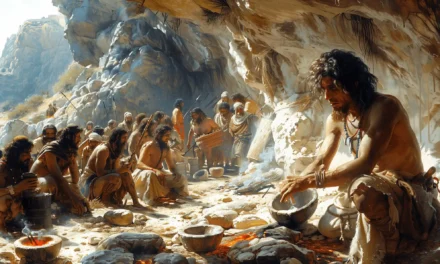Chasing Chili Peppers: Tracing the History of Capsicum
In South America, researchers have unearthed a culinary time capsule! They discovered starch grains of “Capsicum” on artifacts from milling stones and cooking vessels recovered from the floors of two ancient villages in southwestern Ecuador, dating back to around 6,000 years ago

In Mesoamerica, the first signs of chili peppers were hotter than an oven in July! You could say it was like finding the missing piece of the food puzzle. Researchers found wild chiles in a dry cave in Oaxaca, Mexico dating back thousands of years – talk about some ancient spice! What really sealed the deal was Coxcatlan Cave in the Tehuacan Valley, a chili pepper haven preserved since 6,000 BC.
It looks like our ancient ancestors had a knack for spice because evidence suggests they were taming wild Capsicum species during the same era! They must have been trying to put a bit of fire and flavor into their food as if they were adding salt and pepper to their plates.
It’s like searching for the holy grail of plant origins! Regarding domesticating “Capsicum annuum,” the best guesses point to two possible locations in Mexico. It’s either in the northeast or more towards the central-east. But wherever it happened, it clearly gave birth to something special, as this plant has become a favorite worldwide.
As the world moved into the Mid-Holocene period (around 6000 B.P.), these areas around the western and eastern coasts of Mexico, southeast Mexico, and northern Guatemala were the chosen dance partners of the wild chili pepper at the salsa fiesta! This sizzling region had all the right ingredients weather, temperature, and soil – to make it the perfect habitat for this spicy star.
There are around 25 species of “Capsicum,” 17 of them from South America; however, most of the species that have been domesticated come from “Capsicum annuum” that was cultivated in Mexico at least 5.000 years ago.
Bearing the Torch: The Heat Behind the Chili
Chilies are like walking firecrackers! That’s because the key component of chilies, capsaicin, is like a little matchstick of a fiery irritant to our mammal senses. When capsaicin comes into contact with tissue, it’s like that matchstick being lit – the burning sensation is unmistakable! But despite this firecracker-like quality, chilies can actually be very beneficial to our health, helping to prevent the growth of pesky bacteria and fungi.
The evidence suggests that the species of “Capsicum” adapt the concentration and characteristics of Capsaicin depending on the conditions of the environment, the predators from the ecosystem, and the presence of bacteria and fungi.
Spice of Life: Ancient Flavors from the Americas
It looks like the ancient inhabitants of the Americas were really spicing things up! You can tell from their pottery that they liked to add a little heft to their recipes with chili, maize, and cocoa.
Capsicum was on everyone’s mind – even those who were using pottery for daily use and those who used it for ceremonial purposes! It was like a “spice of life” that was admired by ancient civilizations, and its presence on pottery showed that it was highly regarded in their culture. It was a flavor that could be used in many different ways and was one of the most sought-after ingredients of its time.
People in ancient times were just as creative as we are today in their cooking, and they could recognize a good thing when they tasted it; they just didn’t have all the specialized sauces and seasonings we enjoy today.
Feeling the Heat: The Natives’ Taste for Chili
It’s no secret that the natives of the land were truly a flavor-savvy bunch! Aji, a popular seasoning, was an essential ingredient in their wardrobes of flavors. It was sprinkled on food, slipped into beverages, and often used for rituals and medicinal purposes.
In most cases, the natives used salt and chili pepper for seasoning, like a powerful duo of flavors. Even in some regions like the Amazon, chili was the only ingredient the natives had to add some delicious spice to their meals.
It was common for native communities to take a spicy break from chili pepper and other products as part of their traditional ceremonies for the harvest and to show gratitude to the gods.
Thanks to the chronicles from travelers, missionaries, and officers, we know that aji was commonly used by the natives for different seasoning kinds of meals and some beverages.
Savory Seasonings – A Taste of the Spanish Expeditions
Since the first arrival of the adventurous Cristopher Columbus, Chili has been a welcomed companion on Spanish expeditions, spicing up the daily diet of the brave expeditionary forces. Chili has been a faithful knight in shining peppers ever since, a fiery friend to all adventurers who heartily accept its pungent embrace.
Back during the days of the grand expeditions to the Americas, Spanish and Portuguese explorers were bringing a special treat to the tables of Europe and Asia – ají peppers and chilis.
During the colony, Spanish settlers adapted chili pepper to be used in cooking and for seasoning.
South of the Spice Border: Chile and Aji
In Spanish, it is commonly known as “chile” in Mexico and Central America. In contrast, it is widely known in South America as “aji.” In English, “chili” is commonly used to describe sauces and seasonings made using peppers.
In the United States, species of “Capsicum” are commonly known as peppers or hot peppers. This term originated when the Spanish conquerors and settlers associated spicy fruits from the Americas with pepper.




